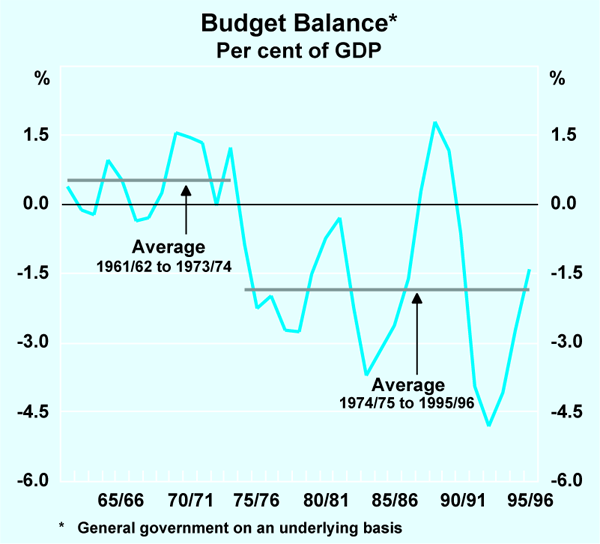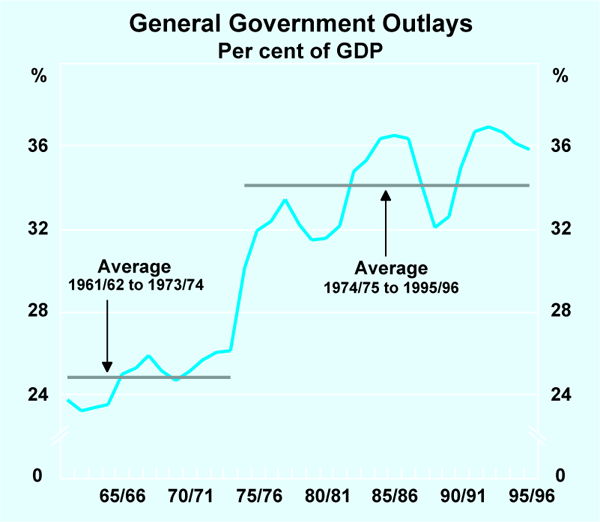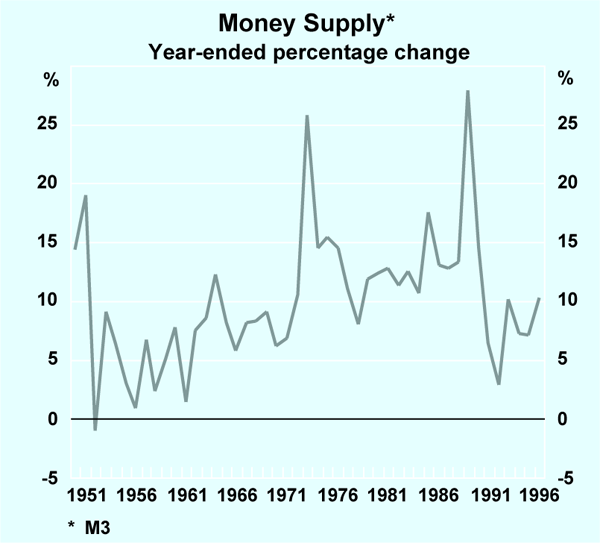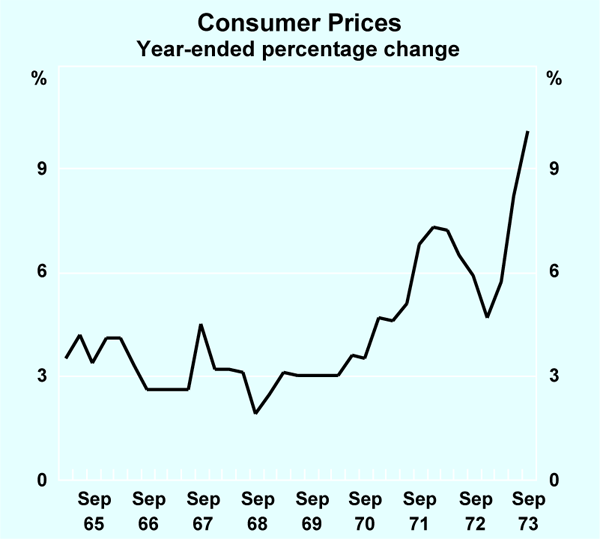Speech The Economics of Nostalgia
Introduction
It is a great pleasure to be speaking at The Sydney Institute, which has done so much over recent years to keep alive informed discussion of public affairs and the arts. In keeping with this tradition, I have chosen to speak on a subject with an historical, economic and political theme. I would like to look back at the 50s and 60s, and evaluate some of the lessons that people take from this period. The further my professional life proceeds, the more value I see in a good knowledge of economic history, even if it is so recent that most of us have lived and worked through it. As you will gather, my views on history are much closer to George Santayana's than to Henry Ford's.
There can be no quibble with the proposition that macro-economic performance in the immediate post-war period, which for present purposes I will refer to as the 50s and 60s, was far superior to any period before or after. This has led a lot of people to use it as a basis for proposing economic policies for today. They look back at how things were done in the 50s and 60s, and say ‘if only we did it the same way today, our macro-economic performance would be as good as it was then’. This approach has some merit but, if we are to use it, it is very important that we get our facts straight about what the policies actually were in the 50s and 60s.
There are two propositions of policy relevance that are frequently made about this period. The first one is that the macroeconomic success at that time was due to the use of activist and expansionary fiscal and monetary policies. The second is that the world economy was moving along very smoothly in the post-war period, with everything under control, until hit by the external shock of the OPEC-induced oil price rise in late 1973 (and again in 1979). I would like to analyse these two propositions with particular reference to Australia, but in doing so it will be necessary to bring in a lot of international economic and political events, particularly those occurring in the United States.
Macro-economic Performance in the 50s and 60s
It is not necessary to spend much time demonstrating how successful this period was in terms of macro-economic performance because no-one disputes it. Table 1 shows that the real growth rate for the world economy was more than twice as high in the 1950–1973 period than in the previous 80 years. In Australia there was also a major improvement, although less than a doubling. Inflation, which had been negligible on average until the Second World War, rose to about 4 per cent in the 1950–1973 period, with the average being pushed up by the Korean War period and the early 70s. At other times it was a good deal lower, and even with these periods included, it was moderate enough to permit economic expansion for most of the period. Unemployment remained low throughout the period, although there was some cyclical movement at times. Overall, macro-economic performance was considerably better in this period than in any time before or since, which has prompted economic historians such as Maddison (1991) to refer to this period as the ‘Golden Age’.
| GDP | CPI | |
|---|---|---|
| 1870–1950 | 2.3 (2.9) | 0.1(c) (1.3) |
| 1950–1973 | 4.9 (4.7) | 4.1 (4.6) |
| 1973–1980 | 2.6 (3.1) | 7.3 (9.7) |
|
(a) Sixteen largest OECD countries. Source: Maddison (1991). |
||
There were a number of factors behind this impressive economic performance, but time and space limit me to mentioning only the main ones. The four most important, I believe, are as follows:
- there was a big gap to be made up following the Depression and the Second World War. The 50s and 60s were a period of post-war reconstruction or ‘catch-up’ for most countries. The largest growth pick-up occurred in the countries most devastated by the war, such as Germany, Italy, Japan and Austria, and the least pronounced (although still significant) was in the United States, Canada, Switzerland, Sweden and Australia;
- although populations and governments were eager for economic growth, there was widespread restraint in economic behaviour. The privations endured during the Depression and the War meant that as incomes rose, a high proportion was saved. Inflationary expectations too had been conditioned by decades of nearly zero inflation, which showed up in modest pricing and wage setting behaviour for much of the period. Some commentators also stress the political cohesion among western countries as a result of the ever-present influence of the Cold War;
- international trade was liberalised and exports and imports grew rapidly. This was a sharp contrast with the inter-war period. Maddison says ‘perhaps the least controversial assertion one can make about the Golden Age is that it involved a remarkable revival of liberalism in international transactions. Trade and payment barriers erected in the 1930s and during the War were removed. The new-style liberalism was buttressed by effective arrangements for regular consultation between western countries and for mutual financial assistance’ (IMF, OECD and GATT (now WTO)); and
- governments conducted good macro-economic policies with a greater emphasis on economic growth than in previous decades. In a number of countries the new-found commitment to growth and low unemployment was enshrined in legislation. In others it was less formal, but in nearly every country the first decades after the Second World War were characterised by well-balanced and successful macro-economic policies. A more detailed examination of these macro-economic policies, particularly in Australia, is the subject of my next section.
The Role of Macro-economic Policies
There is no doubt that the dominant principle behind macro-economic policy changed after the Second World War in line with Keynesian teaching, but the change occurred more quickly in some countries than others.
The main change was that fiscal policy was to be used actively to promote economic growth by deliberately incurring budget deficits at times of weak economic activity. Fiscal policy and monetary policy together were termed demand management policy, and they were to be adjusted to smooth the business cycle, to increase growth and to achieve full employment. In Australia's case, this approach was enshrined in a document – the 1945 White Paper, ‘Full Employment in Australia’.
This approach to policy was very successful in that it achieved its aims of high growth rates and low unemployment for several decades, and it did so with generally low rates of inflation.[1] The achievement was all the greater, given that the 50s contained a major shock in the form of the Korean War commodity price boom. This high level of success has led many people to assume that policy must have been operated with a high degree of activism, ie by choosing very expansionary settings of policy. But this was not the case. For most of the period we are considering, demand management policy was quite restrained and, where necessary, restrictive. Certainly its guiding principle was Keynesian, but it was operated in a very balanced way and was, in any case, subject to an important constraint, which I will come to later.
That this was the case should not be a surprise to people who remember the period. For example, the Fadden ‘Horror Budget' of 1951/52 and the ‘Credit Squeeze’ of 1961, which nearly cost the Menzies Government office, have gone into folklore. Of course, there were also periods where policy was expansionary, but on average the result was relatively balanced. While growth was high, on average, there was also a business cycle operating during this period, with a couple of reasonably clearly defined recessions and booms.
The fact that policy was well balanced can be shown for fiscal policy by a couple of graphs. Unfortunately, comparable data do not go back earlier than 1961/62, so we will have to lose the 50s from our comparisons. Graph 1 shows the best general measure of the underlying budget deficit. In the 12 years from 1961/62 to 1973/74 the budget was, on average, in surplus to the extent of ½ per cent of GDP, and the fluctuations around the average were not very large. In the period since then, the budget has nearly always been in deficit, with an average deficit of nearly 2 per cent of GDP. You can see the three attempts made to bring it back towards surplus – the first one when Mr Howard was Treasurer, the second one under Mr Keating as Treasurer, and the third one which is being continued at the moment by Mr Costello. In summary, it is the more recent period that could be characterised as activist and expansionary in that there are bigger swings in the budgetary position and, on average, it tends to show a much bigger deficit.

Another measure of fiscal activism is the size of government expenditure relative to the economy. It will come as no surprise to see that general government outlays relative to GDP were much lower in the 60s than they are now (Graph 2); in the earlier period they accounted for about 25 per cent of GDP, but over the last two decades they have averaged 34 per cent of GDP.

The stance of monetary policy is more difficult to analyse because interest rates cannot be used as the measure of comparison. This is because before the early 1980s the financial system was heavily regulated, with the Government imposing interest rate ceilings on most forms of lending. Tightenings and easings in monetary policy showed up largely through credit rationing – the ease or difficulty in obtaining a loan at a given interest rate. This would be familiar to people who can remember the difficulty of obtaining a housing mortgage at that time. The best way of judging whether monetary policy was tight or loose in such a system was to see how fast it allowed money and credit to grow. The growth of the money supply is shown in Graph 3, and again we see relatively low and stable expansion during the 50s and 60s (except for the Korean War boom), before the turmoil starts in the 70s (in this case, the very early 70s).

I referred earlier to the fact that monetary and fiscal policy had to operate under an important constraint during the 50s and 60s. The constraint to which I am referring is the gold exchange standard, whereby virtually all OECD countries fixed their exchange rate to the US dollar, which in turn fixed to gold. In Australia's case, our exchange rate to the US dollar did not change between 1949 and 1971. This was in a way the centrepiece of our economic policy. Monetary policy and fiscal policy could not get too expansionary without either inflation or the balance of payments threatening the exchange rate. This mechanism effectively meant that our macro-economic policies (and those of most OECD economies) could not get too far out of line with the policies pursued by the US Government. A recognition of this link means that if we wish to fully understand what happened in the 50s, 60s and early 70s, we have to look more closely at the trends in US economic policy. This also means that we will have to stop looking at the 50s, 60s and early 70s as a whole, and instead divide it into two quite different sub-periods.
The End of the Golden Age
The role of the United States is crucial here. Despite its having enacted the Employment Act of 1946, the United States continued to run reasonably conservative demand management policies through the Truman and Eisenhower years and even in the early part of the Kennedy Presidency. In this period US economic policy came in for a fair bit of criticism from economists, particularly outside the United States, for being too cautious. There was some basis to this criticism in that US policy makers did seem to be less keen to expand than their counterparts in other countries, particularly in Europe.
American attitudes changed in the early 60s, but nothing concrete occurred until the Johnson years. The turning point was the tax cuts introduced in 1964 and 1965 which were described by one of their architects – Arthur Okun – as ‘The largest stimulative fiscal action ever undertaken by the federal government in peacetime … the first major stimulative measure adopted in the post-war era at a time when the economy was neither in, nor threatened imminently by, recession. And, unlike earlier tax reductions, they were taken in a budgetary situation marked by the twin facts that the federal budget was in deficit and federal expenditures were rising’. This certainly got the United States moving and was soon followed by increased defence expenditure occasioned by the Vietnam War, and other government expenditure associated with the Great Society programs. Some of the proponents of the original tax cuts then argued for tax increases but, not surprisingly, they found these were harder to put into place than were the earlier tax cuts.
In the second half of the 60s and early 70s the US economy grew very quickly and inflation began to rise. For a time it was held in check by the Fed's willingness to run tight monetary policy, but with the appointment of Arthur Burns as Fed Chairman, monetary policy became more accommodating. President Nixon found that expansionary policies were popular, and continued in the same vein as his predecessor.[2] By 1971, with the United States running a large current account deficit, it could no longer hold its commitment to gold, and the US dollar was effectively devalued against gold and against other major currencies. There was now no longer an anchor to the international financial system. Thus, the post-war period should really be divided into two sub-periods, with the US tax cuts of 1965 marking a convenient dividing line. Thereafter, US policy became expansionary, and it ceased to provide a constraint on the actions of other countries.[3]
It is instructive to see what happened in a range of countries during this second period, that is between the turning point in US policy in 1965 and the OPEC shock at the end of 1973. The story is very similar for all OECD countries. Their economies continued to grow strongly, but they were not able to get their unemployment any lower than the already low starting point (see Table 2). The main effect of these expansionary policies was to push inflation to levels that were not consistent with sustainable economic growth. As a general rule, most countries' unemployment rates rose slightly, but their inflation rates doubled (see Table 3). By 1972 and 1973 the world economy was in an inflationary boom. How did Australia fare in this period?
| 1965(a) | 1973(a) | |
|---|---|---|
| US | 4.5 | 4.9 |
| Japan | 1.3 | 1.4 |
| Germany | 0.7 | 1.2 |
| France | 1.3 | 2.7 |
| Italy | 5.4 | 6.7 |
| UK | 1.4 | 2.1 |
| Canada | 3.9 | 5.6 |
| Sweden | 1.2 | 2.5 |
| Belgium | 2.5 | 3.7 |
| Netherlands | 1.0 | 3.9 |
| Average of above | 2.1 | 3.1 |
| Australia | 1.6 | 2.3 |
| (a) For 1965, figures are the average for the year; for 1973, they are the average for the first three quarters (ie pre-OPEC I). | ||
| 1965(a) | 1973(a) | |
|---|---|---|
| US | 1.7 | 6.9 |
| Japan | 5.9 | 12.6 |
| Germany | 3.8 | 6.9 |
| France | 2.3 | 7.4 |
| Italy | 3.3 | 11.8 |
| UK | 4.4 | 9.2 |
| Canada | 2.8 | 8.2 |
| Sweden | 6.7 | 9.1 |
| Belgium | 4.0 | 8.8 |
| Netherlands | 6.8 | 8.4 |
| Average of above | 3.2 | 8.4 |
| Australia | 4.1 | 10.4 |
| (a) Year to December 1965 and to September 1973 (ie pre-OPEC I). | ||
Our story was very similar to the general pattern, although the deterioration in inflation was more marked here. Our inflation rate, which had been about 4 per cent in the mid 60s, reached 10.4 per cent in the year to the September quarter of 1973. That means that we had already got our inflation rate into double digits before OPEC came along to deliver a further inflationary impulse (see Graph 4). Our problems were compounded by the inflationary boom that the world found itself in in 1972 and 1973. Commodity prices were rising rapidly, as were our export receipts. With the monetary policy instruments then available, and with the fixed exchange rate, it was not possible to quarantine the monetary effects, and the money supply was soon growing at more than 20 per cent per annum. We did not help ourselves very much either with the way we set wages. The National Wage Case of December 1970 resulted in a 6 per cent increase in awards, and the metals industry award of July 1971 added 9 per cent to award wages through that year (when inflation was 5.1 per cent).

The point of all this analysis is to answer the second proposition that was presented in the Introduction. Was the world achieving good macro-economic performance until hit by the OPEC shocks? The answer is clearly no. In the period after 1965, policies became too ambitious and too expansionary. In colloquial terms, we all lost the plot. Of course, it is easy for me to say these things now because I have the benefit of hindsight – it was much harder at the time to see that we were overstretching ourselves.
By 1973, the world economy already had an entrenched inflationary problem, not just a temporary one as in the Korean War period. Whether OPEC had come along or not, it would still have been necessary to re-examine demand management policies and do something about restoring the sort of conditions that existed in the 1945–65 period. History shows that what we got instead was an oil price shock to add to our already considerable self-imposed troubles, and so spent the next decade-and-a-half trying to return to some sort of reasonable equilibrium. I do not want to say anything about that period because that is another story.
Conclusion
The period that is loosely described as the 50s and 60s really covers the nearly three decades between the end of the Second World War and the first oil price shock known as OPEC I. Macro-economic policies were successful for most of this time in that they avoided the deflation that had characterised the 1930s, and yet did not move too far in the inflationary direction.
However, a closer examination of the whole period suggests that there were two quite distinct sub-periods. The first, from 1945 to 1965 or thereabouts, was the true Golden Age in that sustainable growth with low inflation was achieved against a background of macro-economic policies that did not try to be too ambitious in the short run. The second period, from 1965 to 1973, looked promising for a time, but was ultimately a period of policy failure. Macro-economic policy tried to achieve too much and forgot about the need for sustainability. It ended up with the world economy in an inflationary boom, which set the scene for oil prices to rise sharply, as had all other commodity prices during the boom. A policy reversal aimed at restoring the more balanced approach of the 1945–65 period would have been needed even without the shock of OPEC.
Endnotes
Most economists would object to an approach which sought to attribute successful economic growth over a couple of decades to demand management policies. They would point out that demand management policies, insofar as they impact on economic activity, are meant to offset cyclical movements rather than lift the long-run growth rate. The latter is much more a function of labour force growth, productivity, and the various incentives that operate to encourage the expansion of physical and human capital. The economists' point is correct as a general principle, but the effects of demand management policies can at times be long-lasting. No-one would deny that in the 1930s, for example, deflationary demand management policies had a long-lasting effect. Be that as it may, the point of this talk is to argue against the proposition that a particular type of demand management policy was responsible for growth achieved over a couple of decades. [1]
During this period there was also a belief that the business cycle was a thing of the past, and there should be no future recessions (ie periods of falling GDP). It was also held that the aim of macro-economic policy was to keep output growth continuously at potential, and any shortfall was viewed as a policy failure. (See Okun (1970) for both of these views.) Finally, it was argued that economists should not have a view on the size of the budget deficit; it should be as large as necessary to continuously maintain full employment. All three of these propositions were the conventional wisdom of the OECD when I joined it in 1972, but are now rarely heard. [2]
For good descriptions of US economic policy during this period, see Okun (1970), Samuelson (1995) and De Long (1996). [3]
Bibliography
Australian Bureau of Statistics, Government Financial Statistics, Cat. No. 5512.0.
De Long, J.B. (1996), ‘America's Only Peacetime Inflation: The 1970s’, NBER Working Paper No. 84.
FitzGerald, V.W. (1993), National Saving: A Report to the Treasurer, AGPS, Canberra, June.
Maddison, A. (1991), Dynamic Forces in Capitalist Development: A Long-Run Comparative View, Oxford University Press, Oxford.
Okun, A.M. (1970), The Political Economy of Prosperity, Brookings Institution, Washington, DC.
Pagan, A. (1987), ‘The End of the Long Boom’, in Maddock, R. and McLean, I.W. (eds), The Australian Economy in the Long Run, Cambridge University Press, Cambridge, pp. 106–130.
Samuelson, P.A. and Solow, R.M. (1960), ‘Analytical Aspects of Anti-Inflation Policy’, American Economic Review, 50(2), Papers and Proceedings, May, pp.177–194.
Samuelson, R.J. (1995), The Good Life and its Discontents: The American Dream in the Age of Entitlement 1945–1995, Random House of Canada Limited, Toronto.
Van der Wee, H. (1986), Prosperity and Upheaval: The World Economy 1945–1980, Hogg, R. and Hall, M.R. (trans.), Penguin Books, Harmondsworth.
